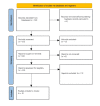The Effect of Therapeutic Approaches on Hallux Valgus Deformity
- PMID: 38779237
- PMCID: PMC11110493
- DOI: 10.7759/cureus.58750
The Effect of Therapeutic Approaches on Hallux Valgus Deformity
Abstract
Hallux valgus (HV) is a relatively frequent disease caused by a complicated structural malformation of the primary ray. The bunion or middle projection generated by the hallux's lateral displacement and pronation is merely one element of the three-dimensional abnormality. HV may trigger severe discomfort and affect joint kinematics. The specific kinematic cause is still unknown. Female age, gender, restrictive footwear, and heritage are risk indicators. HV frequently coexists along metatarsal adducts, equines contracture, hammertoe imperfection, and pes planus. HV is a frequent foot ailment with multiple, complicated, unknown etiology and course. HV has a preference for females. It is an ongoing condition for which there is no known treatment to reduce or prevent improvement. Fibrodysplasia ossificans progressiva (FOP) is distinguished by hereditary symmetrical HV deformities or symptoms that begin heterotopic calcification that is either idiopathic or caused by trauma, such as subcutaneous immunizations. Localized heterotopic calcification may be preceded by aggravating, recurring soft-tissue enlargements (flare-ups). Heterotopic calcification may happen anywhere; however, it most commonly impacts locations near the axial bone structure during the early/mild phases until advancing to the appendicular skeleton. As an effect of calcification affecting the flexibility of the joints, it might cause limitations in motion. The initial line of therapy focuses on non-surgical methods including night splinting, orthotics, and larger shoes. The next suggested line of action is surgical intervention if conservative therapy fails. Patients have good postoperative tolerance, and bone union often happens six to seven weeks after surgery. Stretching exercises help to restore function by extending shortened soft tissue and restoring range of motion (ROM). The goal of joint mobilization, a form of manual treatment method, is to extend the ligament, the soft tissue surrounding the limited joint, and the restricting joint capsule by applying modest amplitude passive movement to the joint components.
Keywords: flexibility; hallux valgus; joint kinematics; physical therapy; soft tissue mobilization.
Copyright © 2024, Khan et al.
Conflict of interest statement
The authors have declared that no competing interests exist.
Figures
References
-
- Hallux valgus: etiology, diagnosis, and therapeutic principles (Article in German) Zirngibl B, Grifka J, Baier C, Götz J. Orthopade. 2017;46:283–296. - PubMed
-
- Hallux valgus. Hecht PJ, Lin TJ. Med Clin North Am. 2014;98:227–232. - PubMed
-
- The pathogenesis of hallux valgus. Perera AM, Mason L, Stephens MM. J Bone Joint Surg Am. 2011;93:1650–1661. - PubMed
-
- A recurrent mutation in the BMP type I receptor ACVR1 causes inherited and sporadic fibrodysplasia ossificans progressiva. Shore EM, Xu M, Feldman GJ, et al. Nat Genet. 2006;38:525–527. - PubMed
-
- Forces acting in the forefoot during normal gait - an estimate. Jacob HA. Clin Biomech (Bristol, Avon) 2001;16:783–792. - PubMed
Publication types
LinkOut - more resources
Full Text Sources
Research Materials

